Display Cable Types
We all have that one drawer/box/bin filled with a mess of cables. We’re likely not even sure what all these cables go to or what the purpose of all these adapters and display ports are. Nevertheless, we keep them in case they become useful. One day, you’ll be setting up a monitor and realize a need for these cables, but just what do they do, and which is the best for your purpose?
We admit, as a tech company, we also have quite a few boxes of cables lying around. Thankfully, it’s our job to know what these cables are, and being a company that focuses on comprehensive IT, we are proud to extend our proven MSP expertise from Stonebridge MSP to Tucson and beyond.
For this blog in particular, we’re going to be focusing on computer display cables.
Why Cables Can Be Tricky
One really important thing to note is just how tricky cables really are—or can be. They’re tricky because sometimes cables are categorized by their appearance and sometimes by their capability.
Some cables with the same appearance will have different capabilities. For example, the Thunderbolt (version 3&4) is a USB-C cable that supports video display but is virtually indistinguishable from other USB-C’s that do not support video display. It is different in name from other USB-C’s but can only be visually set apart by the small lightning bolt symbol featured on it.
Other cables will look different and fit in different ports, but are considered to be the same type of cable. We can see an example of this when comparing the different types of DVI or the different versions of Thunderbolt.
Although the organization of this blog will be by cable name, we will note any instances in which a cable’s appearance might change or when appearances might be deceptive.
The First Thing To Consider
When setting up a computer, you will not always have your pick of cables. Instead, you may be limited by what your devices support. If there are no common cables between the two devices you are connecting, do not worry; there are display cables that go between one type socket to another. In these scenarios it’s generally best to pick the most capable cable on the most limited device, then have that connect to a port that’s at least as good on the other.
Also note that while a socket may fit and display the visuals of a cable, it may not be able to display the new visual standard that particular version of the cable is capable of, depending on the device capabilities.
How To Decide Which Display Cable to Use
Frequently, you will also come across situations where you have a choice of display cables. It is typically best to choose the best display that both of your devices can support if they share more than one supported display.
Below, we’ll detail which display cables do what and how you can tell them apart so that you can make the best decision for your computer setup.
VGA (Video Graphics Array)
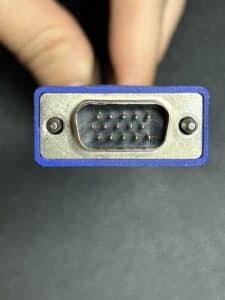
This is an example of what the face of a VGA (video graphics array) looks like.
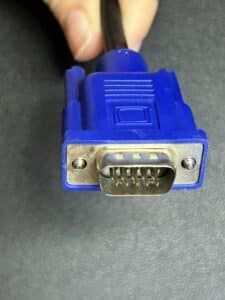
Side view of VGA cable
First on our list of display cables is the VGA, which stands for Video Graphic Array. The VGA was introduced back in 1987 and is being phased out as a supported display by many modern devices. This is because the VGA has a very limited set of capabilities when compared to modern cables. One of the biggest limitations of the VGA is it’s lack of ability to carry audio signals. So, if you’re currently using a VGA, and have been having issues hearing audio, that might just be why. The maximum resolution of the VGA can vary depending on the cable quality, but it generally tops out around 2048×1536 pixels.
VGA’s were originally designed for CRT monitors, now a relic of the past. However, if you have an older computer, it’s possible that your display options are limited, in which case this may be your only option for display.
If you’re looking to identify a VGA cable, you’ll want to look for 15 pins in the center of the cable. The pins are housed inside an upside-down, rounded trapezoid. The cable, like the next on the list, screws in at either side.
DVI (Digital Visual Interface)
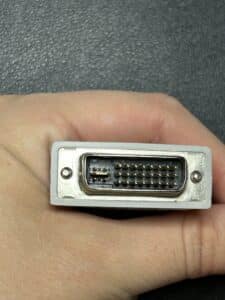
The face of a DVI cable. The most distinguishable difference between a VGA and a DVI is that a DVI has a small horizontal line to the left of the pin cluster(s). This line is sometimes punctuated with 2 pins above and below it ( as in the case with the picture). The rows of pins are also frequently aligned more symmetrically than a VGA and they’re housed in a more rectangular shape.
You can think of the DVI as the younger brother to the VGA with only a slightly elevated level of capability. Introduced in 1999, the DVI is similarly falling out of favor in modern hardware. DVI cables likely have the most diversity in appearance from cable to cable of any we mention today. You can expect to see a change in appearance based upon the type of signal the DVI supports as well as whether the cable is dual or single link.
DVI-A and DVI-I have a small straight line to the left of the pin cluster while DVI-D (depicted in the photo) has the addition of 4 pins around the line, 2 above and 2 below. Both DVI-I and DVI-D will have a pin pattern on the right that varies based on whether or not the cable is dual-link or single-link. DVI-A has one pin arrangement unique to it’s category that does not vary.
You can distinguish between the dual and single links based on whether the pins appear in two square-shaped clusters (single link) or one solid rectangular cluster (dual link).
The various types of DVI’s are distinguished based on the type of signal they support.
- DVI-A (Analog): Supports an analog signals similar to VGA.
- DVI-D (Digital): Supports digital signals and is capable of resolutions up to 2560×1600 at 60 Hz.
- DVI-I (Integrated): Supports both analog and digital signals.
DVI does not natively support audio; it is a video-only standard. While it provides better video quality and higher resolutions than VGA, it has been largely superseded by HDMI, DisplayPort and other successors.
HDMI (High-Definition Multimedia Interface)
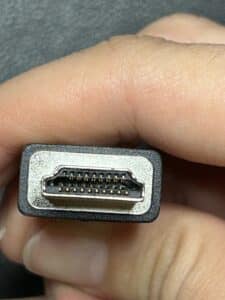
You can identify an HDMI by the shape it has when looking directly at it. HDMI’s should look something like this.

Frequently, HDMI cables will also have HDMI written on them for identification, however, if you’re still having difficulty identifying the cable, look to see if the side resembles the one we’ve photographed in the picture.
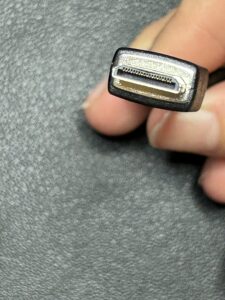
This is the mini HDMI. It’s similar in appearance, except that it is smaller and more rounded.
After the DVI, people were introduced to the HDMI in 2003. HDMI is common today, both in a computer and TV display setup. It supports both video and audio, which explains it’s popularity for home entertainment systems. HDMI has gone through several versions, with each new version bringing improvements such as higher resolutions, faster refresh rates, and support for features like 3D and 4K video.
- HDMI 1.x: Up to 1080p resolution and basic audio support
- HDMI 2.0: Up to 4K at 60 Hz, HDR support
- HDMI 2.1: Up to 8K at 60 Hz, better HDR support, and features like Variable Refresh Rate (VRR)
HDMI is widely used but can be limited in terms of maximum cable length and professional features like daisy-chaining multiple displays, which are more readily available in standards like DisplayPort. Still, for many situations with limited range, the HDMI serves as the “old reliable”. You’ll find many modern computers that offer HDMI as an option, and for most purposes, it provides all the modern features we’ve come to expect in our technology.
HDMI can also come to us in the form of mini HDMI and micro HDMI. This is an important thing to note because, while the capabilities and function may be the same, the actual point at which you connect it to your device will not allow entry for the standard size. Take careful note of this when looking at your devices; make sure not to mix up micro, mini, and standard, as it could result in the purchase of an incompatible cable.
When identifying a standard HDMI, look for a rectangle with two adjacent corners curved inward. The smaller versions are more curved with less rigidity, becoming more similar to a half circle as the size decreases.
DisplayPort
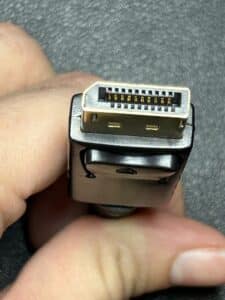
Display ports will look somewhat like the photo shown here. It is somewhat similar to the look of a HDMI but instead of 2 corner missing with a curved edge, the HDMI is a rectangular shape with one corner cropped off.
Introduced in 2006, the simply named “DisplayPort” introduced an even higher performance standard. The DisplayPort contains additional features when compared with the HDMI. This includes higher resolutions, higher refresh rates, and more color depth. DisplayPort versions have evolved quickly.
- DisplayPort 1.2: 4K at 60 Hz, Daisy Chaining (MST)
- DisplayPort 1.3 and 1.4: 5K and 8K resolutions, better audio, HDR support
- DisplayPort 2.0: Up to 10K resolution, even better HDR, and increased performance
DisplayPort is common in professional environments due to its high performance and features, such as the ability to connect multiple displays through a single output using Multi-Stream Transport (MST).
When identifying the DisplayPort, look for a rectangle with one corner “clipped”. It’s important to note that there are mini-display ports as well.
The next picture featured in the blog depicts both the appearance of a mini display port as well as the first and second versions of the thunderbolt. On monitors that require a “thunderbolt”, a mini display cable may not always work in it’s place. Make note of the exact requirements for any device.
When one cable looks identical to another, it’s important to be careful when purchasing. Ensure that the cable is what is required; it should be apparent in the name.
Thunderbolt
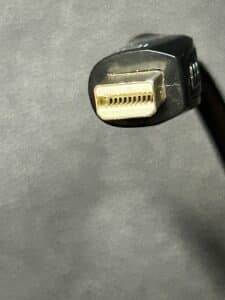
The picture displayed here shows the appearance of a thunderbolt 1&2. The thunderbolt had the same form a Mini Display port but with added capability.
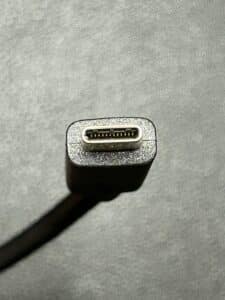
Thunderbolt version 3 & 4. This cable is indistinguishable from other USB-C types.
Introduced in 2011, the Thunderbolt was developed by Intel and Apple and is much more than a display interface; it’s a high-speed data transfer protocol. Thunderbolt ports carry DisplayPort and USB signals in addition to data, making them incredibly versatile. Thunderbolt 3 and 4 use the USB-C connector, making them indistinguishable by sight from USB-C ports. Usually there is a small lightening symbol that can be used to determine if the USB-C is a Thunderbolt/ has video display capabilities.
- Thunderbolt 1 and 2: Up to 20 Gbps, Mini DisplayPort connector
- Thunderbolt 3: Up to 40 Gbps, USB-C connector, 4K at 60 Hz display support
- Thunderbolt 4: Similar to Thunderbolt 3, but with more stringent hardware requirements.
The up-to-date display capability and versatility explain 3 & 4’s increasing popularity in modern devices. It functions as a power delivery, data transfer, and video output all in one cable.
Display Cable Recommendation
Each newer technology generally offers higher bandwidth, better video and audio quality, and additional features like support for multiple displays or improved color spaces, making them more suited for modern display requirements.
Therefore, a general recommendation for display follows the latest…usually that is. Given that USB-C doesn’t offer additional display or audio capabilities and is instead praised for it’s general convenience, it may be smart to go with HDMI or DisplayPort, should you have the option. This is because if the USB-C spot is empty, it frees it up to be used for it’s other capabilities.
Stonebridge is proud to offer MSP to Tucson companies, and we hope you’ll contact us should you have any questions or be in need of any business services.
